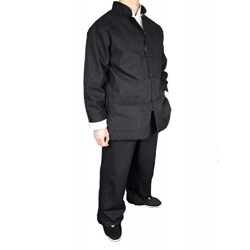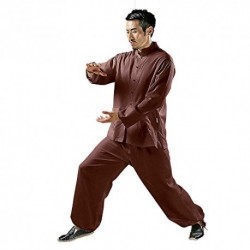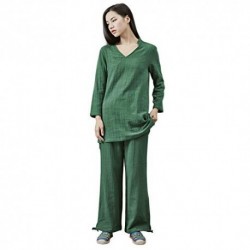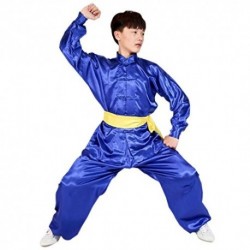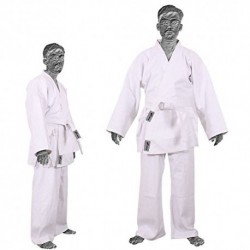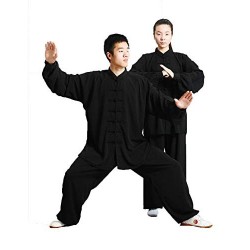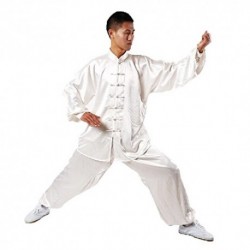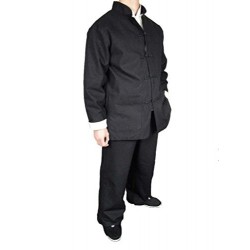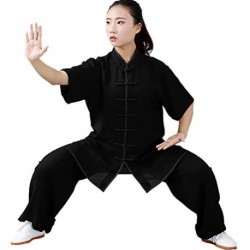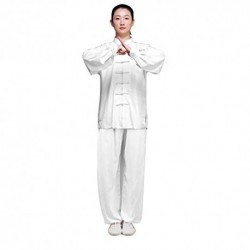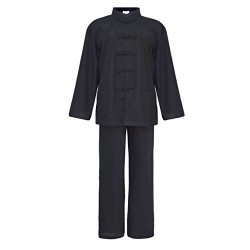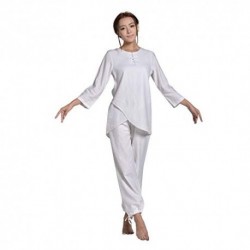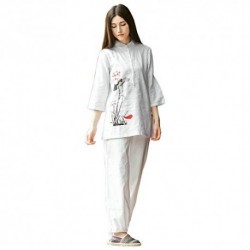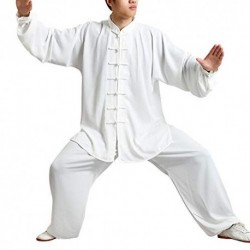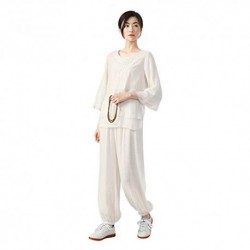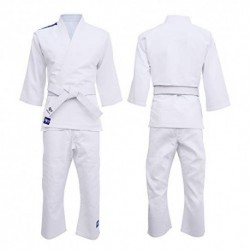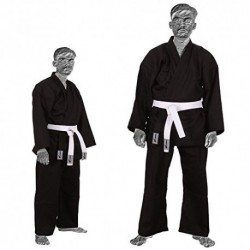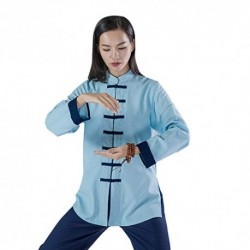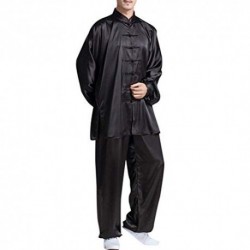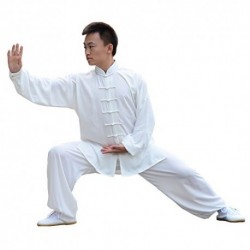BACK TO: MARTIAL ARTS SHOP - BACK TO: MARTIAL ARTS CLOTHING
Clothes / Costumes / Kung Fu Kimonos to buy online. Kung Fu apparel. Online sale of kung fu suits, clothes, kimonos for KUNG FU practices. Complete catalog of kung fu uniforms at a good price.
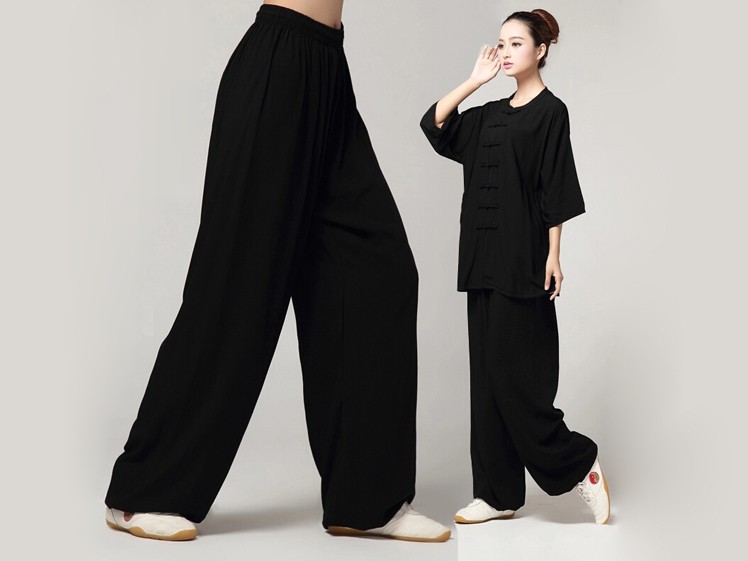
This catalog corresponds to a complete kung fu store , but first, let's do a historical review of this martial discipline.
Buy kung fu costumes and the origins of this discipline
Let's start with an explanation of some terms and expressions. The term "kung fu" (or "gung fu") literally means "achievement through great effort," but it is also taken as the name of a Chinese martial arts group that typically features sharp punches and kicks. The term "kung" means something like achievement or merit, and "fu" can be translated as man. To practice this discipline, the ideal is to get a traditional kung fu suit or kung fu uniform.
Where does the kimono kung fu shaolin really come from?
Many people have the impression that Kung Fu originated in the Shaolin Temple. It didn't. Read on to learn more before buying your kung costumes online. Although many people believe that Chinese martial arts originated in the Shaolin Temple, there is some evidence to suggest that Chinese martial arts developed long before the Shaolin Temple was built. The temple was built in the third century A.D., but there are references to characters such as the physician Hwa Tuo, who used exercises based on animal movements to improve the physical health of his patients long before that date. Hwa Tuo lived at the time of the Three Kingdoms, around 220-65 AD. Hwa Tuo is said to have created a set of exercises based on five animals: the tiger, the bear, the monkey, the stork, and the deer. The reason why this is significant is that even today there is a strong relationship between the animal movement and Chinese martial arts. To perform them all fluently, you need a kung fu suit.
Kimono kung fu shaloin
In fact, the Shaolin temple became a center of martial arts development and remained so for more than a thousand years, before it was dissolved by the Ching Dynasty in the eighteenth century. To learn more, shaolin Temple is located at the foot of "Songshan" mountain in Dengfeng County, Honan Province. It must also be said that there have been many Shaolin temples built throughout China. It is not known if these were established as competitors to the Songshan temple or if they represented an extension of the original Shaolin Temple. In any case, with the practice of martial arts in these temples, the use of Shaolin kung fu costumes also spread.
Who was Da Mo (Bodhidharma) and what is the name of this monk's kung fu suit?
In 527 A.D., a monk known as Da Mo (Bodhidharma) arrived at the Shaolin Temple. Dat Mo is believed to have been an Indian monk who was probably born in Kanchipuram, near Madras. Da Mo traveled to the city of Kuang, now known as Canton, where he was granted an audience with the Emperor of the time, Wu Ti of the Liang Dynasty. The emperor had instructed local Buddhist monks to translate Buddhist texts from Sanskrit into Chinese, with the intention that the general population would have the possibility to practice the Buddhist religion and wear kung fu costumes. After his audience with the Emperor, Dat Mo traveled to a monastery in the Kingdom of Wei, before finally arriving at the Shaolin temple. When Da Mo initially arrived in Shaolin, he was denied entry, perhaps because he was considered a foreigner (he was not yet wearing his kung fu uniform). Rejected by the monks, Da Mo went to a nearby cave and meditated by looking at the cave wall for nine years, until the monks recognized his religious prowess and admitted it. Legend has it that he made a hole in one side of the cave with his constant gaze. Unfortunately, the real reason why Da Mo gained recognition from Shaolin monks has been lost in history. There is also a story that a local monk was so moved by Dat Mo's piety that he cut off one of his hands in sympathy. Once admitted to the temple, Dat Mo is believed to have found his Chinese disciples too weak, both physically and mentally, to wear kung fu kimonos and practice the intensive meditation required by their path to enlightenment. Dat Mo is considered the founder of Chan Buddhism, which is probably best known for its Japanese derivative, Buddhism Zen.
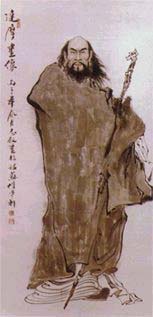
The Shaolin Temple and the Kung Fu Kimono
To end the problem of the monks' health, Dat Mo devised exercises that combined physical movement and breathing, thus strengthening the bodies and minds of his disciples. This allowed them to follow the spiritual path with more vigor. Since Dat Mo himself was of the warrior caste (Ksatriva), it is possible that some of the exercises were derived from the Indian martial tradition. It is evident, therefore, that early Shaolin Kung Fu costumes were largely internal in nature, being designed for the improvement of health, mind control, and perception of Buddha nature. The content of this training has been reduced to the present as:
Ye Gun Kung - Exercises designed to strengthen the physical body by working the tendons. For this discipline he wears a kung fu uniform.
Sai Choi Kung - The art of cleansing (the body - the mind).
Sime Kung - Meditation practice that incorporates: kung fu kimonos, stationary or moving exercises that train the practitioner to feel, improve and finally control the movement of Chi in their body; and spiritual training, an effort to directly perceive one's "Original Face" or "Buddha Nature."
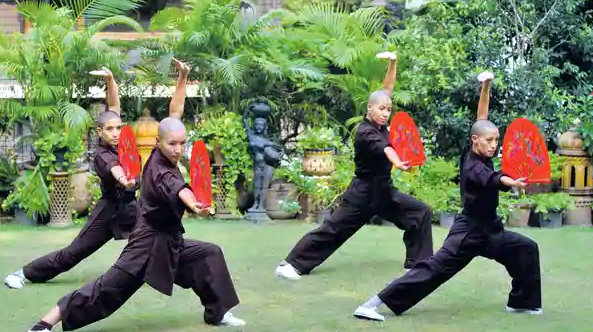
People wearing traditional kung fu costumes or kung fu costume for children.
Chinese martial arts, and indeed all the martial arts that followed, seem to be the result of a mix between India and China, and the passage of people in kung fu costumes between the two counties. Monks and merchants constantly traveled and it is not unreasonable to assume that they required trained guards or even learn themselves to defend themselves. Combined with Dat Mo's intervention in the Shaolin Temple, this has led to what we today call Kung Fu. Lau Gar is a form of Kung Fu and as such would also have its roots in the Shaolin Temple.
What is the name of the kung fu suit?
Oddly enough, there is no exact name for what the kung fu suit is called. It has been popularly designated by teachers and practitioners as:
- Kung fu suit
- Kung fu clothing
- Kimono kung fu
- Kung fu uniform
- Kung fu suit for children (children)
The most accepted version for its Chinese name is probably Gi, which means kimono in Chinese. So to give it a more traditional name in Chinese, we're probably talking about a kung fu Gi when we want to refer to the costume in a formal way. They can usually be found in a kung fu shop and are black in color.
Is there a kung fu suit for children?
Yes. Obviously, we also have the kimono or children's kung fu suit. It is basically the same as that of an adult, but adapted to the measurements of a child. Buying it is really an educational alternative for children who are beginning to be interested in traditional Japanese culture. To keep them in touch with the exciting world of martial arts, which are a disciplined and orderly way of life, there is nothing like giving a child an original kung fu suit.
What is the kimono or kung fu suit?
Kung fu costumes are cheap. You will realize this right away, as soon as you take a look at the catalog that we show you. For a kung fu suit the price is usually less than 100 €. Unless we are talking about a traditional Chinese suit of high-end or higher quality, the price of kung fu clothing does not exceed the mentioned quantity.
There are kung fu clothes and suits for men, kung fu suits for women, children... Take a look at the catalog of kung fu costumes with shipping to your city or province: Barcelona, Valencia, Madrid, Seville, Canary Islands, Balearic Islands, Cádiz, Galicia, Basque Country... Buy your kung fu suit in Spain.
KUNG FU CLOTHING There are 63 products.
- 0 Review(s)
Fine linen black kung fu martial arts tai...
100 % PROFESSIONALLY HEAD TO MANO & NATURAL LIGHT TELLS: Each of these Kungfu Tai Chi suits is handmade by our partner and professional tailor, Mr. Sze, who has more than 28 years of experience. / PERFECT FOR THE DEPORTE & DIARY USE: 100% Fine linen and soft cotton inner lining. Respirable, durable and comfortable for your daily activitiesFREE SASTRERY:...
132,00 € - 0 Review(s)
KSUA Men Tai Chi Uniform Kung Fu Chinese...
MATERIAL PREMIUM: made of cotton and linen material made of high quality; breathable and absorbing moisture, relaxing, comfortable and resistant to fungi; Inelastic but loose.SIMPLE DESIGN: Pure Handcraft, the long-sleeved uniform features traditional anuded Chinese buttons and mandarin collar, the pants have elastic waist and drawstring design on the...
41,99 € - 0 Review(s)
KSUA Meditation costume Zen for Women Kung...
CHINE STYLE DESIGN: Pure Handcraft, the new and improved version of long sleeves with collar in Chinese V, pants with elastic waist and cord design on the legs of the pants.MATERIAL PREMIUM: made of high quality handmade cotton material; breathable and absorbing moisture, relaxing, comfortable and resistant to fungi; Inelastic but loose.ROPA COMFORTAL:...
40,99 € - 0 Review(s)
BOZEVON Unisex Children Tai Chi Clothing...
100 new and high quality!Material: polyesterThe package includes: 1 piece Tops + 1 piece of trousers (1 piece of free belt included)Comfortable and durable use. They're soft and classic.DO NOT use the Amazon size guide, see our size guide, choose the correct size.
24,06 € - 0 Review(s)
TurnerMAX - Karate Kimono Martial Arts...
Generously cut suit that gets confused often the most expensiveMade of 100% pure cottonKarate suit is double seam in the seams that provides additional strengthElastic tape with laces in karate pantsThe jacket is more time to stop on horseback along the tape
33,93 € - 0 Review(s)
GEGEQ® kung fu tai chi shaolin clothes tai...
1. Fabric: cotton and silky silky silkworm, soft, breathable.2. Tai Chi Shi Clothing: Tai Chi is a kind of Chinese fuse. Zhang Sanfeng in ancient China created Tai Chi, using the energy of nature, and the power of infinite. Put yourself in our Tai Chi suit and get the energy of nature.3. The most respectful with the environment, original: cotton fabric...
29,99 € - 0 Review(s)
Andux - Chinese traditional Chinese...
Appropriate for: Men and Women Material: Korea silk (70% silk + 30% polyester) Loose Fitting Tai Chi UniformInteract China pure, fresh, comfortable and light about 400 gIncludes shirt and trousers, long sleeve buttons features uniform frog and neck mandarin, pants have elastic waist and legGreater comfort.. They are soft and elegant. in the practice of...
39,46 € - 0 Review(s)
Premium linen black kung fu martial arts...
Quality of Factory,Made to Professional Hand, 28Años de Corte ExpertSoft and White Cotton lining for the Greater ComfortChinese Fashion Necklace; Chinese Buttons; Fold by White MangaCotton Belt for Good Flexibility PantsFree custom request according to your need to reach your demand
152,00 € - 0 Review(s)
Unisex tai chi tang costume martial arts...
The package includes: 1 short sleeve piece Tops + 1 piece trousersUnisex martial arts suits, which provide sufficient flexibility for the most active exercise, can be used outdoors or indoors.Soft and elegant, In Tai Chi's practice, the uniform makes the practitioner feel comfortable, meeting the requirements of Tai Chi's practice.Suitable for Tai Chi,...
34,99 € - 0 Review(s)
KIKIGOAL Taijiquan Clothes Practice, Tai...
Material: cotton and silkColor: white, red wine, purple, blue, blackSize: M, L, XL, XXL, XXXL, XXXXL (reference size) men and women with paragraphWeight: 0.7kg.Applicable scenes: Tai Chi, body of fitness, defense of martial arts, current sports
49,99 € - 0 Review(s)
Laciteinterdite Men Tai chi Uniform...
Men's Bribe Traditional Chinese Tai Chi suit, ideal for Kung Fu practice, Casual or for comfortable daily training.Jacket: 5 Frog Buttons, 2 patch pockets, tangerine neck, sleeve with satin white lining.Pant: elastic waistband with cord, 2 side pockets.Material: 55% linen 45% cottonPlease refer to the detail size information in product description to find...
49,00 € - 0 Review(s)
KSUA Women's Martial Arts Uniform Kung Fu...
MATERIAL PREMIUM: Handmade with cotton material and handmade linen of high quality; breathable and moisture absorbing, relaxing, comfortable, that will prevent excessive breath and keep the body comfortable.; Inelastic but loose.TRADICIONAL DESIGN CHINE: pure crafts, three-quarter sleeves The Tai Chi uniform features traditional Chinese covered buttons,...
39,99 € - 0 Review(s)
KSUA Meditation costume Zen for Women Tai...
MATERIAL PREMIUM: made of cotton and linen material made of high quality; breathable and absorbing moisture, relaxing, comfortable and resistant to fungi; Inelastic but loose.CHINE STYLE DESIGN: Pure Handcraft, 3/4 sleeve uniform with Chinese ink print and mandarin collar, the pants have elastic waist and cord design on the legs of the pants.ROPA...
39,99 € - 0 Review(s)
Yudesun Uniform Traditional Martials...
★ Note: choose a size based on your height, according to the size picture we provide, choose the correct size, not according to the size picture provided by Amazon.★ PORTÁTIL, LIGERO AND CONVENIENTE - so that it can be taken anywhere, at any time.★ RESPIRABLE: is made of high-quality breathable synthetic silk that prevents excessive breath and keeps the...
36,99 € - 0 Review(s)
KSUA Women Tai Chi Uniforme Kung Fu Chino...
MATERIAL PREMIUM: made of cotton and linen material made of high quality; breathable and absorbing moisture, relaxing, comfortable and resistant to fungi; Inelastic but loose.Traditional Chinese design: pure craftsmanship, Tai Chi uniform for women KSUA with classic Chinese round neck, pants with elastic waist and elastic design on the legs.ROPA...
42,99 € - 0 Review(s)
Starpro Uniform Judo Costume Training -...
▷✅ble and Reliable: the uniform tissue of this child is not healed, that is, it shrinks by 6-8% in the first wash. The Gi is light, convenient and reliable to protect your child from scratches, scratches, cuts and abrasion. This makes it ideal for regular training and combat.▷✅CALLITY: The shirt is made of 190% ± 3% in a mixture of cotton and polyester of...
34,49 € - 0 Review(s)
TurnerMAX - KWON DO Uniform Kids Jiu Jitsu...
Generously cut suit that gets confused often the most expensiveMade of 100% pure cottonKarate suit is double seam in the seams that provides additional strengthElastic tape with laces in karate pantsThe jacket is more time to stop on horseback along the tape
27,70 € - 0 Review(s)
KSUA Uniform Martial Arts for Women Tai...
MATERIAL PREMIUM: made of cotton and linen material made of high quality; breathable and absorbing moisture, relaxing, comfortable and resistant to fungi; Inelastic but loose.CHINE STYLE DESIGN: Pure Handcraft, this long-sleeved uniform features frogs and Chinese neck, pants with elastic waist and elastic pants legs.ROPA COMFORTAL: Soft and Relax. In the...
41,99 € - 0 Review(s)
besbomig Classic Unisexo Costumes Tang...
Excellent traditional clothing concept: includes shirt and pants, long sleeve uniform with frog buttonsSoft and light use offer for theme parties, Halloween, morning exercise, holiday activity and moreSuitable for: Adult men and women (it is recommended that you choose the largest size because Asian sizes are usually small)In the practice of Chinese Tai...
13,21 € - 0 Review(s)
E-Bestar - Tai Chi and Kung Fu uniform...
Material: silk imitation + cotton.Color: white milky.Specifications:Fabric: resistant, soft, elegant and fresh, flexible and anti-wrinkle.Neck: neck with vertical design edge, following the traditional Chinese culture that fully expresses the practical value.
49,99 €


